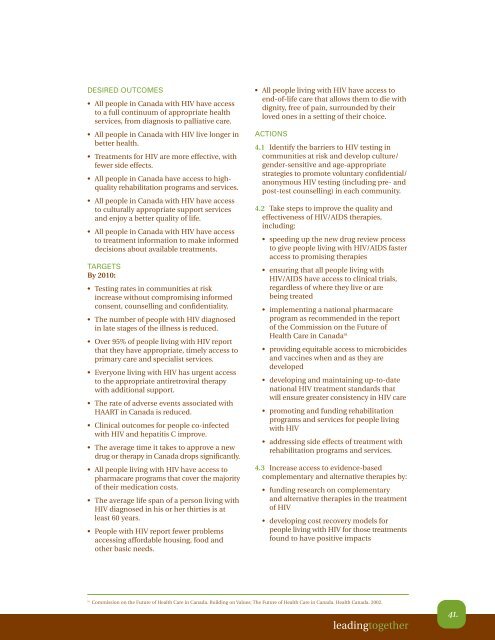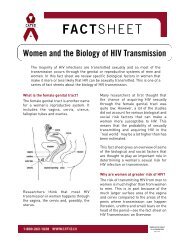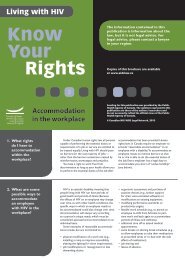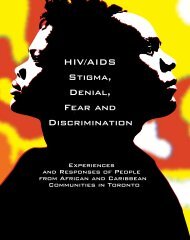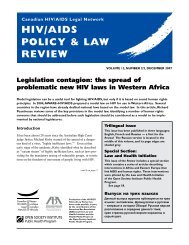Increasing access to testingPeople who are diagnosed early and offeredappropriate treatment and support livelonger in better health than those who arenot diagnosed until late in the course of HIVdisease. They are also better able to preventthe spread of HIV to others. When voluntaryHIV testing is accompanied by pre- and posttestcounselling – as it always should be – itis both an effective early intervention (i.e., agood way to link people who are infected withcare) and an effective prevention strategy(i.e., it gives those who may be engaging inrisky behaviours information and supportfor behaviour change).All testing should continue to be undertakenonly with pre- and post-test counselling andinformed consent, and people should opt inrather than opt out of testing. Promotingaccess to voluntary testing to communitieswith high rates of HIV infection (i.e., gay men,people who use injection drugs, Aboriginalpeople and people from countries where HIVis endemic) is a cost-effective way to detectthe virus early and link people with HIV tosupport, information and treatment that canprolong their lives.Improving treatment effectivenessAfter more than a decade of experiencewith HAART, clinicians and people living withHIV are identifying problems with treatmentfailures, drug resistance and side effects andthe challenges of treating people who areco-infected with hepatitis C or who haveconcurrent disorders, such as mental healthproblems or addictions. Changing and complexcare needs highlight the need to continue todevelop: new, more effective treatments;strategies to overcome barriers to adherenceand reduce drug resistance, such as simplertreatment regimens; vaccines; and a cure.Strategies also need to be developed toaddress the currently poorer treatmentoutcomes for women.Improving access to treatmentMany Canadians with HIV – such as thosein small, rural or remote communities, thosein correctional facilities, new immigrants,Aboriginal persons, women, poor people,people who use injection drugs and sexworkers – continue to face inherent barriersto accessing treatment. Some barriers relateto geography and distance, some to cultureand language, some to bureaucracy andregulation, others to stigma and discrimination.For example, people who use injection drugsare sometimes denied access to antiretroviraltherapy on the assumption that they willnot be able to adhere to complex treatmentregimens; however, recent research indicatesthat, with appropriate education and support,people who inject drugs have the sameadherence rates as other people with HIV. 89Prisoners in Canadian provincial/territorialand federal prisons continue to have problemsaccessing treatment equivalent to that outside.In particular, there is evidence suggesting thata significant number of prisoners discontinueantiretroviral treatment while in prison. 90Access to medical marijuana remains anissue for PHAs.Strengthening support servicesPeople with HIV are a highly diverse group,socio-economically and culturally. Whilesome are working and managing their illness,a growing number are struggling to meetbasic needs and to live a full life in the midstof a long-term, life-threatening illness. Theyneed a wide range of culturally appropriatesupport services that can assist with practicalas well as psychosocial needs – housing andfood as well as social support and preventionstrategies. Many of the services that peoplewith HIV need are beyond the traditionalmandate of care and support programs.To meet these needs, services must adapt.Providing quality end-of-life careWith the advent of HAART in the 1990s, manyof the buddy and hospice programs developedfor people living with HIV in the 1980s havebeen closed down or reduced. With the numberof people being diagnosed in late stages of thedisease, the increase in drug resistance, morepeople failing on HAART, and the sometimeslife-threatening side effects of treatment, morepeople are once again dying from HIV/AIDSand need access to compassionate hospicepalliative care.40.89Canadian AIDS Treatment Information Exchange. Anti-HIV Agents: Teaching Adherence to Substance Users. Treatment Update 127. May 23, 2002;Canadian HIV/AIDS Legal Network. Injection Drug Use and HIV/AIDS. Legal and Ethical Issues, 1999.90Palepu A, Tyndall MW, Li K, Yip B, Hogg RS, O’Shaughnessy MV, Montaner J, Schechter M. Access and sustainability of antiretroviral therapyamong injection drug users in Vancouver. Canadian Journal of Infectious Diseases 2001; Suppl B:32B; Altice FL, Mostashari F, Friedland GH.Trust and acceptance of and adherence to antiretroviral therapy. Journal of Acquired Immune Deficiency Syndromes 2001; 28(1): 47-58;Kerr T, Marshall A, Walsh J, Palepu A, Tyndall MW, Hogg RS, Montaner J, Wood E. Determinants of highly active antiretroviral discontinuationamong injection drug users. Canadian Journal of Infectious Diseases 2004; 15 (Suppl A): 86A (abstract 458P).
DESIRED OUTCOMES• All people in Canada with HIV have accessto a full continuum of appropriate healthservices, from diagnosis to palliative care.• All people in Canada with HIV live longer inbetter health.• Treatments for HIV are more effective, withfewer side effects.• All people in Canada have access to highqualityrehabilitation programs and services.• All people in Canada with HIV have accessto culturally appropriate support servicesand enjoy a better quality of life.• All people in Canada with HIV have accessto treatment information to make informeddecisions about available treatments.TARGETSBy 2010:• Testing rates in communities at riskincrease without compromising informedconsent, counselling and confidentiality.• The number of people with HIV diagnosedin late stages of the illness is reduced.• Over 95% of people living with HIV reportthat they have appropriate, timely access toprimary care and specialist services.• Everyone living with HIV has urgent accessto the appropriate antiretroviral therapywith additional support.• The rate of adverse events associated withHAART in Canada is reduced.• Clinical outcomes for people co-infectedwith HIV and hepatitis C improve.• The average time it takes to approve a newdrug or therapy in Canada drops significantly.• All people living with HIV have access topharmacare programs that cover the majorityof their medication costs.• The average life span of a person living withHIV diagnosed in his or her thirties is atleast 60 years.• People with HIV report fewer problemsaccessing affordable housing, food andother basic needs.• All people living with HIV have access toend-of-life care that allows them to die withdignity, free of pain, surrounded by theirloved ones in a setting of their choice.ACTIONS4.1 Identify the barriers to HIV testing incommunities at risk and develop culture/gender-sensitive and age-appropriatestrategies to promote voluntary confidential/anonymous HIV testing (including pre- andpost-test counselling) in each community.4.2 Take steps to improve the quality andeffectiveness of HIV/AIDS therapies,including:• speeding up the new drug review processto give people living with HIV/AIDS fasteraccess to promising therapies• ensuring that all people living withHIV/AIDS have access to clinical trials,regardless of where they live or arebeing treated• implementing a national pharmacareprogram as recommended in the reportof the Commission on the Future ofHealth Care in Canada 91• providing equitable access to microbicidesand vaccines when and as they aredeveloped• developing and maintaining up-to-datenational HIV treatment standards thatwill ensure greater consistency in HIV care• promoting and funding rehabilitationprograms and services for people livingwith HIV• addressing side effects of treatment withrehabilitation programs and services.4.3 Increase access to evidence-basedcomplementary and alternative therapies by:• funding research on complementaryand alternative therapies in the treatmentof HIV• developing cost recovery models forpeople living with HIV for those treatmentsfound to have positive impacts91Commission on the Future of Health Care in Canada. Building on Values; The Future of Health Care in Canada. Health Canada. 2002.<strong>leadingtogether</strong>41.


